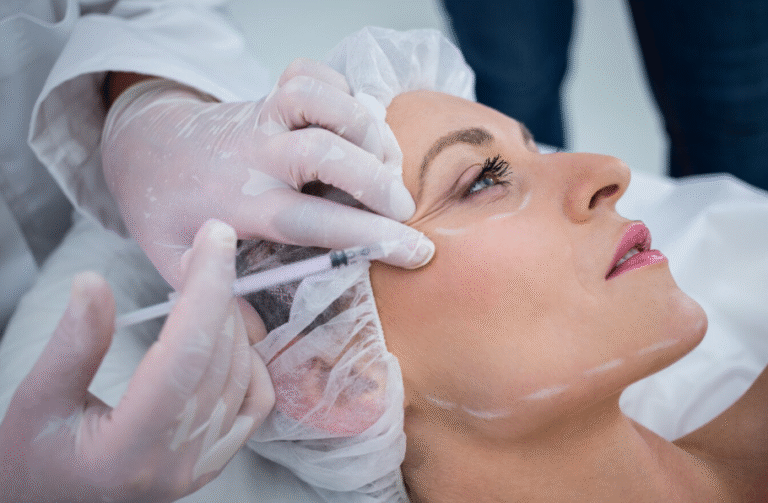Treatment Overview
Reconstructive Rhinoplasty is a specialized nose surgery aimed at restoring both the form and function of the nose after trauma, congenital deformities, or failed previous surgeries. Unlike cosmetic rhinoplasty, which primarily focuses on aesthetics, reconstructive rhinoplasty requires advanced surgical techniques to rebuild nasal structures, restore breathing, and achieve a natural appearance.
In Korea, reconstructive rhinoplasty is performed by highly skilled surgeons who are internationally recognized for their expertise in complex nasal reconstructions. Using cartilage grafts, implants, and microsurgical precision, Korean clinics deliver outcomes that balance function and beauty, making Korea a global leader in reconstructive nasal surgery.
Purpose & Benefits
The main purpose of reconstructive rhinoplasty is to restore nasal integrity and improve quality of life. Key benefits include:
- Restores normal nasal breathing function.
- Reconstructs damaged or collapsed nasal structures.
- Corrects congenital deformities such as cleft lip-related nasal asymmetry.
- Repairs trauma-related injuries (fractures, burns, or skin loss).
- Improves aesthetics while maintaining functional balance.
- Provides psychological benefits by restoring confidence and self-image.
Ideal Candidates
Reconstructive rhinoplasty in Korea is suitable for individuals who:
- Have experienced nasal trauma or severe injury.
- Suffer from congenital nasal deformities (e.g., cleft-related nasal issues).
- Require correction of collapsed nasal bridges or tips due to disease or prior surgery.
- Have undergone failed cosmetic or functional rhinoplasty and need advanced reconstruction.
- Want both aesthetic refinement and functional improvement.
Possible Risks & Complications
As a complex surgery, reconstructive rhinoplasty carries certain risks, although minimized in Korea’s advanced clinics:
- Prolonged swelling and bruising.
- Graft absorption or warping (rare with autologous cartilage).
- Infection around grafts or implants.
- Visible scarring in extensive reconstructions.
- Asymmetry during healing.
- Need for staged or secondary surgeries in severe cases.
Surgical Techniques Used
Korean surgeons employ highly specialized techniques depending on the cause and severity of nasal deformity:
- Cartilage Grafting: Using septal, ear (auricular), or rib (costal) cartilage for rebuilding nasal framework.
- Columellar Strut or Shield Grafts: To support and define the nasal tip.
- Dorsal Onlay Grafts/Implants: For restoring nasal bridge height and contour.
- Flap Reconstruction: Local or regional flaps to repair skin defects from trauma or disease.
- Septal Reconstruction/Septoplasty: To restore proper breathing function.
- Combination Techniques: Integration of functional and cosmetic rhinoplasty methods for optimal balance.
Recovery & Aftercare
- Initial Phase: Swelling, bruising, and discomfort are most noticeable in the first 1–2 weeks.
- Stitches/Splint Removal: Within 7–10 days depending on complexity.
- Downtime: Most patients resume light activities in 2 weeks, but full recovery may take longer due to reconstruction.
- Healing Duration: Complete healing and stabilization of results often require 6–12 months, especially in complex reconstructions.
- Aftercare in Korea: Advanced scar management, swelling-reduction therapies, and regular follow-ups ensure optimal outcomes.
Results & Longevity
Reconstructive rhinoplasty delivers life-changing, long-term results by restoring both appearance and breathing. With Korean techniques emphasizing stability and natural aesthetics, patients enjoy permanent improvements. In some severe trauma or congenital cases, staged surgeries may be required, but outcomes are generally stable for a lifetime once fully healed.
Treatment Process in Korea
Korea is globally recognized for combining medical artistry with advanced technology, making it a top destination for reconstructive nasal surgery.
Consultation:
- In-depth facial and functional analysis using 3D imaging and CT scans.
- Customized treatment planning based on trauma history or deformity severity.
Pre-Surgery Care:
- Medical assessments, donor site planning (rib, ear, septum).
- Detailed discussions about staged surgery if necessary.
Surgery:
- Duration: 3–6 hours depending on complexity.
- Performed under general anesthesia.
- Surgeons carefully rebuild nasal framework using cartilage, grafts, or flaps.
Post-Surgery Care:
- Specialized swelling-reduction therapies (LED, ultrasound, laser).
- Scar minimization treatments.
- Frequent follow-ups to monitor graft integration and healing.
Why Korea?
- Expertise in complex reconstructions (post-trauma, congenital, or revision).
- Use of advanced grafting techniques for stable long-term results.
- English-speaking staff and full medical tourism support for international patients.
Cost Range
The cost of reconstructive rhinoplasty in Korea depends heavily on the complexity, grafting methods, and whether staged surgeries are required.
- General Price Range: ₩8,000,000 – ₩20,000,000 KRW (approx. $6,000 – $15,000 USD).
- Basic Packages Include: Consultation, anesthesia, surgery, and routine aftercare.
- Premium Packages May Include:
- Multiple graft harvest sites (rib/ear cartilage).
- Staged surgery planning.
- Specialized scar and swelling management programs.
- VIP recovery rooms and medical tourism concierge services.
Compared to Western countries, Korea offers more affordable reconstructive options with advanced surgical artistry, making it a leading destination for patients worldwide.
Popular Clinics
- Seoul National University Hospital – Department of Plastic & Reconstructive Surgery: Known for complex trauma and congenital cases.
- ID Hospital (Seoul): Specialized reconstructive and revision rhinoplasty center with international recognition.
- Banobagi Plastic Surgery Clinic: Expertise in restoring nasal function and aesthetics after trauma.
- JW Plastic Surgery Clinic: Advanced grafting techniques for severe deformities.
- View Plastic Surgery Clinic: Offers comprehensive reconstructive care with scar-minimization strategies.




